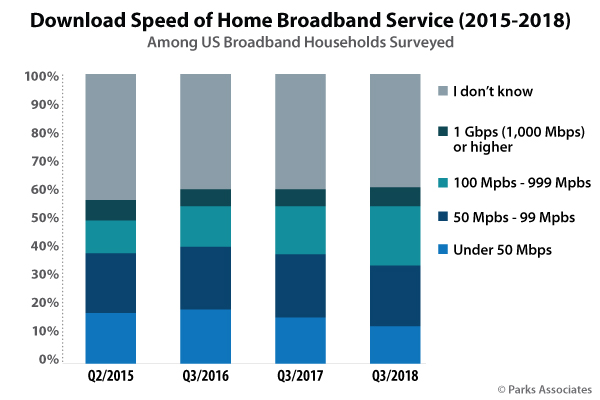What's Holding Back Adoption of Gigabit Speed Broadband?
It’s no secret that US broadband households are a bandwidth hungry group. Driven by increasing numbers of connected devices in the home, greater consumption of streaming media, and always-on access and Wi-Fi, consumers are steadily opting for faster broadband connections.
Parks Associates research shows that average service speeds among US broadband households have steadily increased over the last four years. The most dramatic shift has taken place in the 100 Mbps-999 Mbps tier; it almost doubled since mid-2015 as subscribers to lower-tiered services upgraded their plans.

In light of this consumer migration to higher speed services, it’s surprising how few households are choosing to adopt the fastest service tier—that of gigabit speed connections. Capable of exponentially faster speeds than average home connections, broadband providers have promoted these services as logical (or ideal) solutions for today’s multi-device, high broadband consumption households. Despite significant provider promotion and investments in delivery networks, consumer adoption of gigabit services has been tepid, plateauing at 6% over the last two years. Parks Associates research has identified four key factors negatively impacting adoption:
- Limited Product Availability. Prior to 2017, gigabit speed services were only available to 4% of US households.
- Alternative Service Speeds. In many markets consumers are presented with a variety of service speed options. Despite interest in gigabit services, most select a lower speed after reviewing the options.
- Price Sensitivity. Budget constrained consumers are hesitant to pay the premium of a top tier of service. The availability of suitable service packages priced slightly less than gigabit offerings is sufficient to deter these consumers from upgrading to gigabit services.
- Lack of Compelling Use Cases. Despite increased broadband consumption, consumers are challenged to see a compelling need for gigabit services and have little incentive to adopt these services.
These factors combined have created a market where less than half of consumers are likely to upgrade to gigabit services within the next 12 months, down from 60% just two years ago. To address these challenges service providers are deploying a variety of strategies, including: network expansion to increase product availability, targeting attractive user segments (such as gamers), differentiation through unique pricing, and bundling packages/altering promotional messages to shift purchase criteria away from pure speed.
For a more detailed assessment of the gigabit speed broadband market, including details on consumer sentiment and successful vendor strategies to stimulate adoption, check out the Parks Associates industry report Modern Broadband: Competition and Retention at Gigabit Speeds.
Further Reading:
- Examining Broadband Cord Cutters
- Changing Dynamics of the Smart Home: Opportunities for Service Providers
- Over half of US broadband households who trial an OTT video subscription service convert to paying subscribers
Next: Content Remains the Ultimate Deciding Factor for Consumers
Previous: Sinclair Purchase of RSNs Bolsters Bargaining Power with Pay-TV Providers
Comments
-
Be the first to leave a comment.
Post a Comment
Have a comment? Login or create an account to start a discussion.


